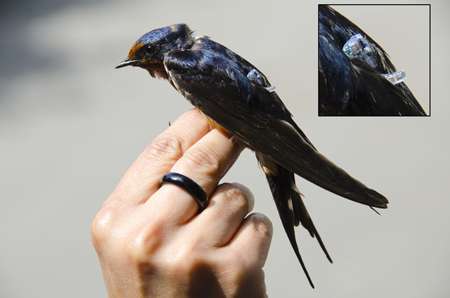Combining techniques provides new insight into bird migration

Two complementary methods work together in a study forthcoming in The Auk: Ornithological Advances, producing more refined estimates of where individual Barn Swallows spend the winter. Using the methods separately comes with tradeoffs—one lets researchers precisely track a handful of birds, while the other provides data for larger numbers but with less detail—but together, they provide a fuller picture of an intercontinental migration.
Barn Swallows (Hirundo rustica) breed in North America but, like many birds, head south for the winter, to a broad area that encompasses most of Central America, the Caribbean, and South America. Keith Hobson and Kevin Kardynal of Environment Canada were looking for a better way to determine where within this range individual Barn Swallows were spending the winter months. Their solution was to combine isotope analysis, which involves sampling the isotopes of elements in birds' feathers for clues about where the birds were when those feathers grew, with a geolocator study, where birds are fitted with small devices that calculate and record their location based on daylight—the catch being that the birds have to be recaptured when they return in order to download the data.
The proportion of hydrogen isotopes in water varies with latitude in North America, but this latitudinal pattern breaks down in South America. So, Hobson and Kardynal combined hydrogen isotope analysis with analysis of carbon isotopes, which reveal whether a bird spent its time in grasslands or forests, and sulfur isotopes, which are affected by whether a bird was on the coast or inland. In addition to collecting feathers from 208 Barn Swallows for isotope analysis, they were able to recapture 14 swallows to which they had attached geolocators, helping confirm that the locations inferred from isotopes were accurate. Most of the birds in their study turned out to be wintering in open agricultural and savanna regions outside of the Amazon basin.
Hobson and Kardynal were motivated to pursue this research because understanding birds' seasonal movements can be crucial for conservation. If birds that breed in a certain area also winter together in a certain area rather than spreading across South America for the winter season, a pattern known as migratory connectivity, then that segment of the breeding population could be wiped out by a single adverse event on their wintering grounds.
"I think the study nicely demonstrates the need to get away from the dichotomous thinking of pitting one technique against another. All are useful and all have their strengths and weaknesses if you take the time to understand them," says Hobson. "On a more serious note, we also need to remember that describing connectivity patterns is a very preliminary step in using such information to help conserve species and populations. I think there is a tendency these days to move on after we have produced some pretty maps."
More information: "An isotope (δ34S) filter and geolocator results constrain a dual feather isoscape (δ2H, δ13C) to identify the wintering grounds of North American Barn Swallows" will be available December 30, 2015, at www.aoucospubs.org/toc/tauk/133/1
Provided by The Auk



















